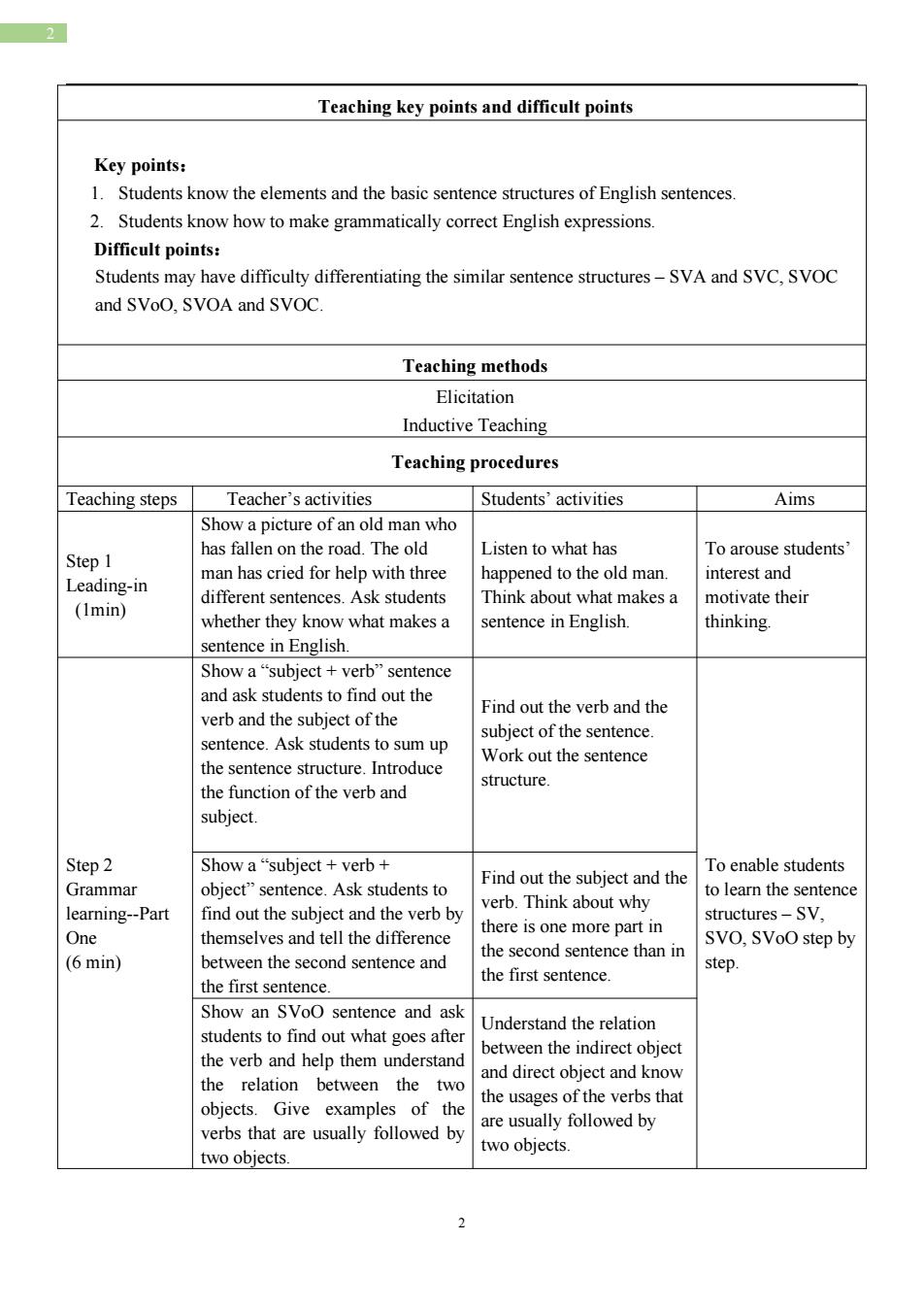正在加载图片...

Teaching key points and difficult points Key points: 1.Students know the elements and the basic sentence structures of English sentences. 2.Students know how to make grammatically correct English expressions. Difficult points: Students may have difficulty differentiating the similar sentence structures-SVA and SVC,SVOC and SVoO.SVOA and SVOC. Teaching methods Elicitation Inductive Teaching Teaching procedures Teaching steps Teacher's activities Students'activities Aims Show a picture of an old man who has fallen on the road.The old Listen to what has Step 1 To arouse students' Leading-in man has cried for help with three happened to the old man. interest and different sentences.Ask students Think about what makes a motivate their (1min) whether they know what makes a sentence in English. thinking. sentence in English. Show a“subject+verb”sentence and ask students to find out the Find out the verb and the verb and the subject of the subject of the sentence. sentence.Ask students to sum up Work out the sentence the sentence structure.Introduce structure. the function of the verb and subject. Step2 Show a“subject+verb+ To enable students Find out the subject and the Grammar object"sentence.Ask students to to learn the sentence learning--Part find out the subject and the verb by verb.Think about why structures-SV, One themselves and tell the difference there is one more part in the second sentence than in SVO,SVoO step by (6 min) between the second sentence and step. the first sentence. the first sentence. Show an SVoO sentence and ask Understand the relation students to find out what goes after between the indirect object the verb and help them understand and direct object and know the relation between the two the usages of the verbs that objects.Give examples of the are usually followed by verbs that are usually followed by two objects. two objects. 22 2 Teaching key points and difficult points Key points: 1. Students know the elements and the basic sentence structures of English sentences. 2. Students know how to make grammatically correct English expressions. Difficult points: Students may have difficulty differentiating the similar sentence structures – SVA and SVC, SVOC and SVoO, SVOA and SVOC. Teaching methods Elicitation Inductive Teaching Teaching procedures Teaching steps Teacher’s activities Students’ activities Aims Step 1 Leading-in (1min) Show a picture of an old man who has fallen on the road. The old man has cried for help with three different sentences. Ask students whether they know what makes a sentence in English. Listen to what has happened to the old man. Think about what makes a sentence in English. To arouse students’ interest and motivate their thinking. Step 2 Grammar learning--Part One (6 min) Show a “subject + verb” sentence and ask students to find out the verb and the subject of the sentence. Ask students to sum up the sentence structure. Introduce the function of the verb and subject. Find out the verb and the subject of the sentence. Work out the sentence structure. To enable students to learn the sentence structures – SV, SVO, SVoO step by step. Show a “subject + verb + object” sentence. Ask students to find out the subject and the verb by themselves and tell the difference between the second sentence and the first sentence. Find out the subject and the verb. Think about why there is one more part in the second sentence than in the first sentence. Show an SVoO sentence and ask students to find out what goes after the verb and help them understand the relation between the two objects. Give examples of the verbs that are usually followed by two objects. Understand the relation between the indirect object and direct object and know the usages of the verbs that are usually followed by two objects